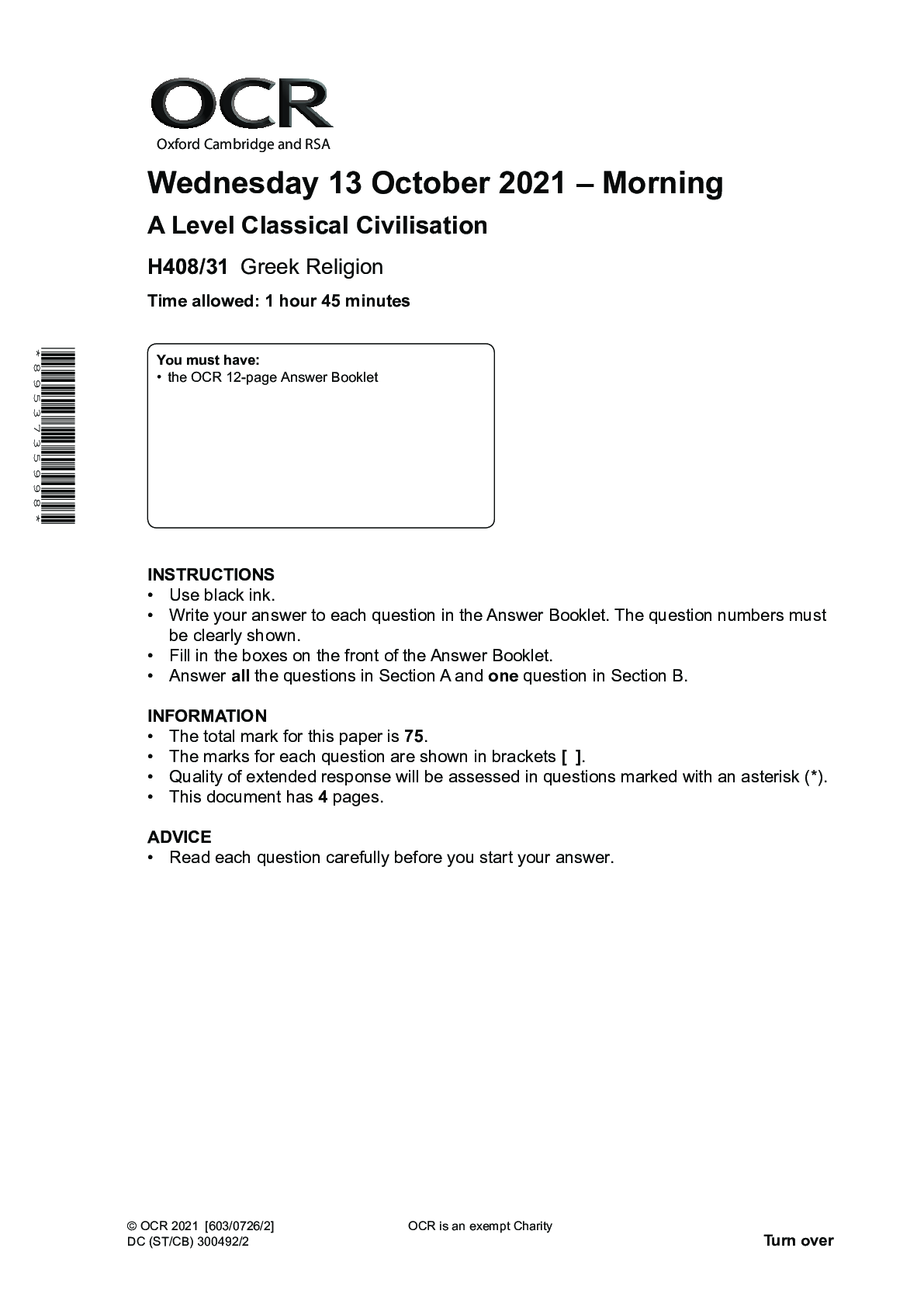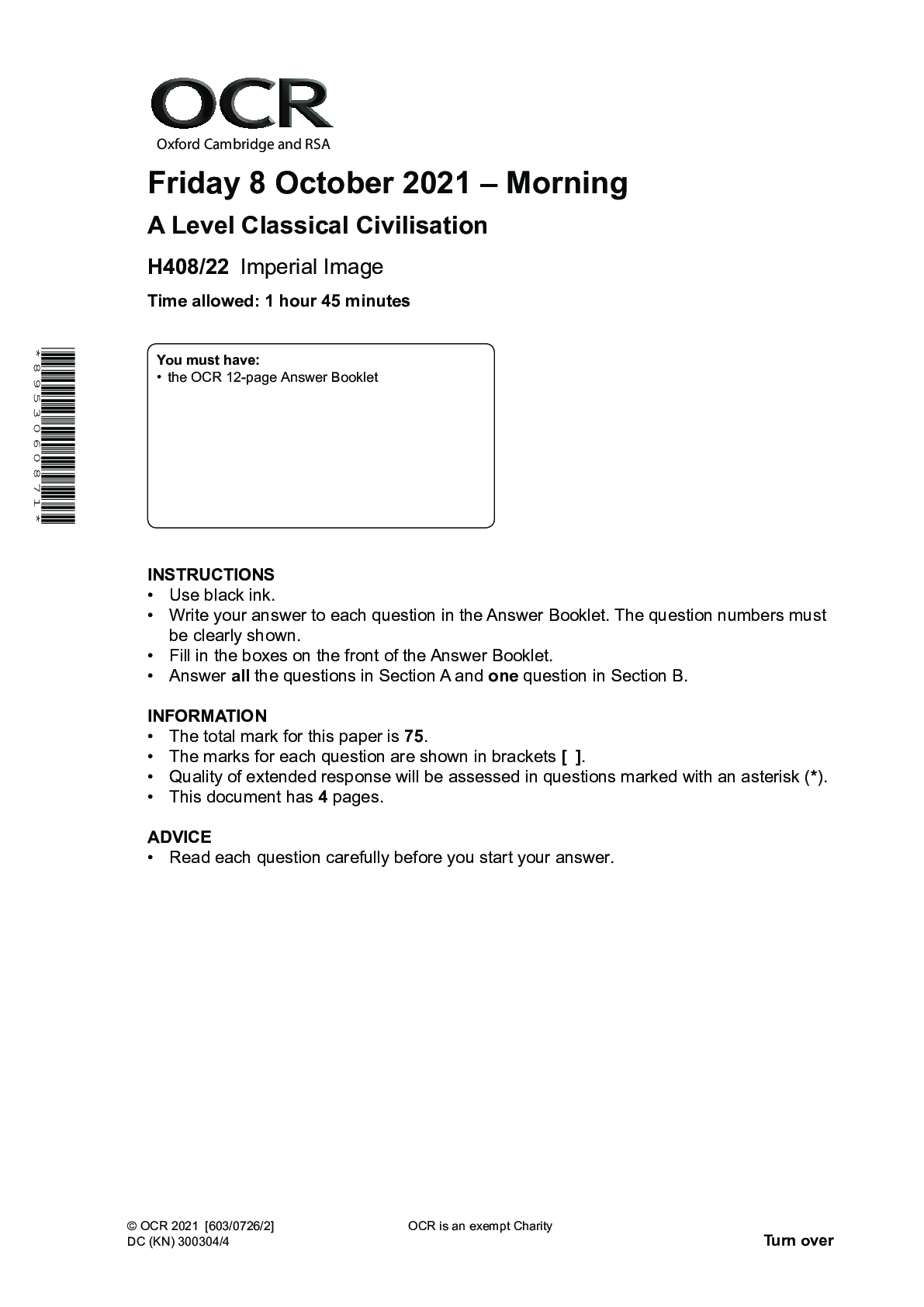English > QUESTION PAPER & MARK SCHEME > A Level English Language H470/01 Exploring language & MARKING SCHEME (All)
A Level English Language H470/01 Exploring language & MARKING SCHEME
Document Content and Description Below
SECTION A – Language under the microscope You are advised to spend about 40 minutes on this section. Read Text A in your Resource Booklet and answer the following questions. 1 Giving careful cons... ideration to the context of the text: (a) Identify and analyse patterns of lexical and semantic use. [10] (b) Identify and analyse the way sentences are constructed. [10] SECTION B – Writing about a topical language issue You are advised to spend about 45 minutes on this section. 2 ‘Changes in popular culture (one example is music) produce too much fresh terminology too quickly; it is impossible to keep up.’ Write a speech to make to your English class, arguing either for or against the statement. You could focus on the example mentioned or on others. Your speech should contain a strong opening and clear argument. It should consider a range of views. It should be no more than 500 words. [24] 3 © OCR 2021 H470/01 Oct21 SECTION C – Comparing and contrasting texts You are advised to spend about 1 hour and 5 minutes on this section. Approximately 15 minutes should be spent reading and preparing your answer and approximately 50 minutes writing your response. Read Texts B and C in your Resource Booklet and answer the following question. 3 Using appropriate linguistic concepts and methods, analyse the ways in which language is used in these two texts. In your answer you should: • explore connections and variations between the texts • consider how contextual factors contribute to the construction of meaning. [36] END OF QUESTION PAPER 4 © OCR 2021 H470/01 Oct21 Oxford Cambridge and RSA Copyright Information OCR is committed to seeking permission to reproduce all third-party content that it uses in its assessment materials. OCR has attempted to identify and contact all copyright holders whose work is used in this paper. To avoid the issue of disclosure of answer-related information to candidates, all copyright acknowledgements are reproduced in the OCR Copyright Acknowledgements Booklet. This is produced for each series of examinations and is freely available to download from our public website (www.ocr.org.uk) after the live examination series. If OCR has unwittingly failed to correctly acknowledge or clear any third-party content in this assessment material, OCR will be happy to correct its mistake at the earliest possible opportunity. For queries or further information please contact The OCR Copyright Team, The Triangle Building, Shaftesbury Road, Cambridge CB2 8EA. OCR is part of the Cambridge Assessment Group; Cambridge Assessment is the brand name of University of Cambridge Local Examinations Syndicate (UCLES), which is itself a department of the University of Cambridge. Oxford Cambridge and RSA Examinations GCE English Language H470/01: Exploring language Advanced GCE Mark Scheme for Autumn 2021 Oxford Cambridge and RSA Examinations OCR (Oxford Cambridge and RSA) is a leading UK awarding body, providing a wide range of qualifications to meet the needs of candidates of all ages and abilities. OCR qualifications include AS/A Levels, Diplomas, GCSEs, Cambridge Nationals, Cambridge Technicals, Functional Skills, Key Skills, Entry Level qualifications, NVQs and vocational qualifications in areas such as IT, business, languages, teaching/training, administration and secretarial skills. It is also responsible for developing new specifications to meet national requirements and the needs of students and teachers. OCR is a not-for-profit organisation; any surplus made is invested back into the establishment to help towards the development of qualifications and support, which keep pace with the changing needs of today’s society. This mark scheme is published as an aid to teachers and students, to indicate the requirements of the examination. It shows the basis on which marks were awarded by examiners. It does not indicate the details of the discussions which took place at an examiners’ meeting before marking commenced. All examiners are instructed that alternative correct answers and unexpected approaches in candidates’ scripts must be given marks that fairly reflect the relevant knowledge and skills demonstrated. Mark schemes should be read in conjunction with the published question papers and the report on the examination. © OCR 2021 H470/01 Mark Scheme October 2021 Annotations H470/01 Mark Scheme October 2021 PAPER-SPECIFIC INSTRUCTIONS: H470/01 Exploring language Candidates answer all the questions on the paper. The paper addresses all of the assessment objectives: Assessment Objectives AO1 and AO3 are addressed in question 1. Assessment Objectives AO2 and AO5 are addressed in question 2. Assessment Objectives AO1, AO3 and AO4 are addressed in question 3. In each question, the assessment objectives are given equal weighting. THE INDICATIVE CONTENT FOR EACH TASK provides an indication of what candidates are likely to cover. The notes are neither prescriptive nor exhaustive: candidates should be rewarded for any relevant response which appropriately addresses the Assessment Objectives. THE LEVEL DESCRIPTORS FOR EACH QUESTION FOLLOW THE INDICATIVE CONTENT. SUBJECT-SPECIFIC INSTRUCTIONS: ENGLISH LANGUAGE • Each level descriptor covers the relevant assessment objectives. • Where the assessment objectives appear in separate columns, marks should be allocated for each assessment objective independently of one another. There is no requirement for responses to be allocated marks from within the same level across each assessment objective. • An answer does not have to meet all the requirements of a level descriptor before being placed in that level. The extent to which it meets all of the requirements of a level descriptor will determine its placement within that level. • The extent to which the statements within the level have been achieved should be the only criteria used when deciding the mark within a level. • Indicative content indicates possible points candidates might make, but this is not an exhaustive account. Any valid response should be rewarded. H470/01 Mark Scheme October 2021 Indicative Content – Please note: indicative content indicates possible points candidates might make, but this is not an exhaustive account. Any valid response should be rewarded. Question Guidance Marks Text features 1 Text A is an extract from the introductory page of Lonely Planet’s guide to exploring Ireland written by the editor. It was published in 2017. Giving careful consideration to the context of the text: (a) Identify and analyse patterns of lexical and semantic use. (b) Identify and analyse the way sentences are constructed. Possibilities are provided below for guidance but any valid response should be rewarded. General contextual points (AO3): Candidates will bring to bear their knowledge of travel guides and the positive representation of Ireland which would be expected given the purpose of the text, which is to inform and encourage prospective tourists to visit the country. Candidates might also consider that the audience will be wide and mainstream and therefore an accessible register will be used. Contextually, Ireland is a popular holiday destination for UK tourists and students can comment where appropriate on the close relationship between the two countries and the positive stereotypical characteristics that are included in this opening. It is also worth noting that the register, although friendly and personable, is not directly attributed to anybody and is the result of a collection of editors’ comments. This is a legitimate consideration in any analysis of 20 In each of the bullet points below, AO1 is covered at the start of the point and AO3 at the end. (a) identify and analyse uses of lexis in this text. Possible features could be: • use of rhetorical tropes such as antistrophe/juxtaposition deliberately contrasting scale in opening sentence (‘A small country with a big reputation…’) to appeal to cultureconscious tourists with short breaks in mind • conversational register with second person pronouns (‘You’ll’) to emulate the words and wisdom of a confidante who the reader will trust when making big decisions such as travelling abroad • geographical Proper Nouns (‘Connemara’, ‘County Donegal’) which is expected given the genre of a travel guide to orientate the tourist • positive semantic field including adjectives such as ‘rich’, ‘warm’ and ‘breathtaking’ to sell the experience of Ireland • Irish lexis is used (‘tá fáilte romhat’) which is accompanied with phonetic spellings (‘taw fallcha row-at’) to assist the prospective tourist with understanding the English translation (‘You’re very welcome’) • metaphorical language is present through distinct verb choices (‘The Irish summer is awash with festivals’) to concisely promote the number and variety H470/01 Mark Scheme October 2021 personal voice. The discourse structure of the text is important to address contextually with a mixture of graphological and structural features to guide the reader through appropriate subheadings and summaries. (b) identify and analyse the way sentences are constructed in this text. Possible features could be: • imperatives (‘Don’t think the Ireland of postcards…’) which mirrors spoken discourse with the editors advising their reader as they would a friend • syntax is broken with spoken asides (‘sunny’ of course being a relative term)’ to humour the UK reader in terms of what weather to expect • triadic listing as a rhetorical scheme with each clause beginning with a material verb (‘see a play…experience a traditional music ‘session’…attend a rock gig’) to showcase the many different activities available in Ireland • non-standard syntax is present through fronted conjunctions (‘And there’s history so young…But lest you think’) to portray the infinite number of possibilities and opportunities to tourists looking to holiday in the country • incongruity across clauses creates humour with a semantic contradiction (‘excess is encouraged, so long as it’s practised in moderation’) H470/01 Mark Scheme October 2021 There are a total of 20 marks available for Question 1. 10 marks can be awarded for part (a) and 10 marks for part (b). There is one mark per level for each AO. This table should be used twice – firstly to mark part (a) and allocate a mark out of 10, and then again to mark part (b) and allocate a mark out of 10. Parts (a) and (b) focus on different language levels, and therefore each part could achieve different language levels. Each part should be marked completely separately – there is no need to look for consistency in allocating marks if the responses demonstrate different levels of competency. Level AO1 and AO3 Mark 5 • Candidates clearly identify patterns of language use in precise relation to the linguistic level specified in the task and can closely analyse incisively chosen evidence, with application of appropriate terminology; the writing is in a secure academic register. (AO1) • With a precise hold on the language feature specified in the task, candidates perceptively evaluate the possible effect of contextual factors on the way language is produced in this text and is received and understood by its audience. (AO3) 9–10 4 • Candidates can single out and analyse relevant examples of language use related to the linguistic level specified in the task, with application of appropriate terminology and coherent written expression. (AO1) • Focusing on the language feature specified in the task, candidates can convincingly weigh up some possible effects of contextual factors on the way language is produced in this text and the way it is receive [Show More]
Last updated: 2 years ago
Preview 1 out of 23 pages

Buy this document to get the full access instantly
Instant Download Access after purchase
Buy NowInstant download
We Accept:

Reviews( 0 )
$11.00
Can't find what you want? Try our AI powered Search
Document information
Connected school, study & course
About the document
Uploaded On
Jul 16, 2022
Number of pages
23
Written in
Additional information
This document has been written for:
Uploaded
Jul 16, 2022
Downloads
0
Views
163

.png)




.png)
.png)

.png)


.png)

